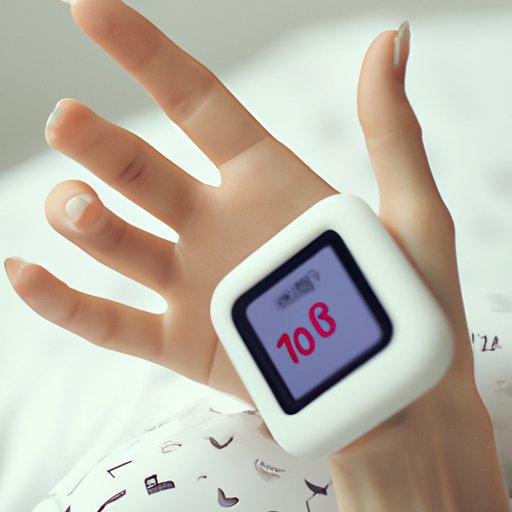Introduction
Your resting heart rate (RHR) is a measure of your heart’s efficiency as it pumps blood throughout your body. It is typically measured in beats per minute (BPM). Knowing what is considered a healthy resting heart rate for women can help to improve overall health and wellbeing. In this article, we will explore the average resting heart rate range for women, how to measure your own resting heart rate, the benefits of knowing your resting heart rate, factors that affect a woman’s ideal resting heart rate, and tips for keeping your resting heart rate in the healthy range.

Exploring the Average Resting Heart Rate for Women
The average resting heart rate for women is between 60 and 100 BPM, according to the American Heart Association. However, there are several factors that can affect a woman’s individual resting heart rate, such as age, fitness level, and stress levels.
Overview of Average Resting Heart Rate
According to a study published in the journal Circulation Research, the average resting heart rate for women aged 18-49 is 72 BPM. For postmenopausal women, the average resting heart rate is higher at 80 BPM. The study also found that younger women tend to have lower resting heart rates than older women.
Factors That Affect Average Resting Heart Rate
Age is one of the most important factors that affects a woman’s resting heart rate. Generally, younger women tend to have lower resting heart rates than older women. Fitness level also has an effect on resting heart rate, with more fit individuals having lower resting heart rates than those who are less fit. Lastly, stress levels can have a significant impact on resting heart rate. High levels of stress can cause a person’s resting heart rate to increase, while low levels of stress can lead to a decrease in resting heart rate.
How to Measure Your Own Resting Heart Rate
Measuring your own resting heart rate is relatively simple and can be done in just a few minutes. It is important to ensure that you are not engaging in any physical activity when measuring your resting heart rate, as this can cause inaccuracies in the results.
Steps for Measuring Resting Heart Rate
To accurately measure your own resting heart rate, follow these steps:
- Find your pulse on the inside of your wrist or neck.
- Using a watch or clock with a second hand, count the number of beats for 15 seconds.
- Multiply this number by four to calculate your resting heart rate for one minute.
Tips for Accurately Measuring Resting Heart Rate
When measuring your resting heart rate, it is important to ensure that you are in a relaxed state. Try to avoid activities such as exercise, caffeine, or alcohol before taking your measurements. Additionally, it is best to take your readings in the morning after you wake up, as this is when your heart rate is usually at its lowest.

The Benefits of Knowing Your Resting Heart Rate
Knowing your resting heart rate can provide valuable insight into your overall health and wellbeing. Regularly measuring your resting heart rate can help you to identify any potential health issues and make changes to improve your cardiovascular health.
Improved Cardiovascular Health
Having a healthy resting heart rate can help to reduce your risk of developing certain cardiovascular diseases, such as heart attack and stroke. According to a study published in the journal Circulation, people with higher resting heart rates are at a higher risk of developing cardiovascular disease than those with lower resting heart rates.
Better Understanding of Overall Health
Measuring your resting heart rate can also give you a better understanding of your overall health and fitness level. If your resting heart rate is higher than normal, it may indicate that you are not as physically fit as you should be. On the other hand, if your resting heart rate is lower than normal, it may indicate that you are in good health.
Factors That Affect a Woman’s Ideal Resting Heart Rate
In addition to age and fitness level, there are several other factors that can affect a woman’s ideal resting heart rate. Stress levels, in particular, can have a significant impact on a woman’s resting heart rate.
Age
As mentioned earlier, age is one of the most important factors that affects a woman’s resting heart rate. Generally, younger women tend to have lower resting heart rates than older women. A woman’s age can also affect her ideal resting heart rate, as older women tend to have higher ideal resting heart rates than younger women.
Fitness Level
Fitness level is another factor that can affect a woman’s ideal resting heart rate. Generally, more fit individuals tend to have lower resting heart rates than those who are less fit. This is because the heart is able to pump more efficiently when it is in better shape.
Stress Levels
High levels of stress can cause a person’s resting heart rate to increase, while low levels of stress can lead to a decrease in resting heart rate. It is important to manage stress levels in order to keep your resting heart rate in the healthy range.

Tips for Keeping Your Resting Heart Rate in the Healthy Range
There are several steps that you can take to ensure that your resting heart rate stays in the healthy range. These include regular exercise, proper diet, and stress management techniques.
Regular Exercise
Regular exercise is one of the best ways to keep your resting heart rate in the healthy range. Exercise helps to strengthen your heart muscle, making it more efficient at pumping blood throughout your body. Aim for at least 30 minutes of physical activity each day to keep your resting heart rate in the healthy range.
Proper Diet
Eating a balanced diet is also important for keeping your resting heart rate in the healthy range. Eating foods that are rich in nutrients, such as fruits and vegetables, can help to keep your heart healthy and functioning properly. Additionally, avoiding processed and sugary foods can help to keep your resting heart rate in the healthy range.
Stress Management Techniques
Finally, practicing stress management techniques can help to keep your resting heart rate in the healthy range. Activities such as yoga, meditation, and deep breathing can help to reduce stress levels and keep your heart rate in the healthy range.
Conclusion
Knowing what is considered a healthy resting heart rate for women can help to improve overall health and wellbeing. The average resting heart rate for women is between 60 and 100 BPM. However, there are several factors that can affect a woman’s individual resting heart rate, such as age, fitness level, and stress levels. Measuring your own resting heart rate is relatively simple and can provide valuable insight into your overall health and wellbeing. Additionally, there are several steps that you can take to ensure that your resting heart rate stays in the healthy range, such as regular exercise, proper diet, and stress management techniques.
(Note: Is this article not meeting your expectations? Do you have knowledge or insights to share? Unlock new opportunities and expand your reach by joining our authors team. Click Registration to join us and share your expertise with our readers.)
